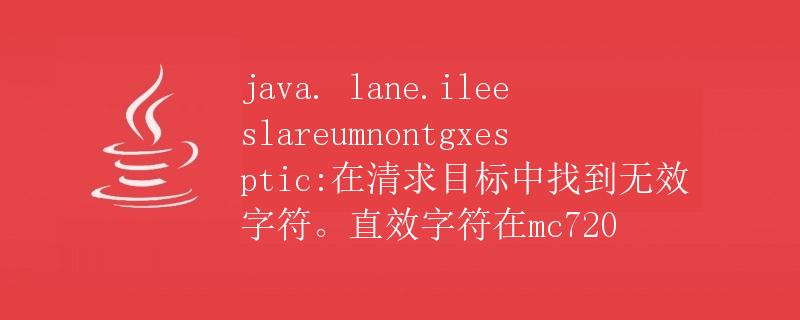Java中的异常处理

在编程中,异常是指程序在运行时出现的不正常情况。Java语言中的异常是一个对象,它派生于Throwable类。在 Java 中,异常分为两种:受检异常和未受检异常。
受检异常(Checked Exception)
受检异常是那些程序在编译时必须处理的异常,即通过 try-catch 或 throws 关键字进行处理。受检异常都是 Exception 类或其子类的实例,但不包括 RuntimeException 及其子类的实例。
受检异常的处理方法有两种:
- 使用 try-catch 语句捕获异常
public class CheckedEx {
public static void main(String[] args) {
try {
int result = divide(10, 0);
System.out.println("Result: " + result);
} catch (ArithmeticException e) {
System.out.println("Caught an ArithmeticException");
e.printStackTrace();
}
}
public static int divide(int dividend, int divisor) throws ArithmeticException {
return dividend / divisor;
}
}
上述代码中,我们定义了一个方法 divide,用于计算两个数的商,在 main 方法中通过 try-catch 语句捕获 ArithmeticException 异常。如果除数为 0,会抛出 ArithmeticException 异常,进入 catch 块进行异常处理。
运行结果:
Caught an ArithmeticException
java.lang.ArithmeticException: / by zero
at CheckedEx.divide(CheckedEx.java:13)
at CheckedEx.main(CheckedEx.java:5)
- 使用 throws 关键字声明异常
当方法内部抛出异常,但不想在方法内部处理异常时,可以使用 throws 关键字将异常抛出到调用者。
public class CheckedEx {
public static void main(String[] args) {
try {
int result = divide(10, 0);
System.out.println("Result: " + result);
} catch (ArithmeticException e) {
System.out.println("Caught an ArithmeticException");
e.printStackTrace();
}
}
public static int divide(int dividend, int divisor) throws ArithmeticException {
if (divisor == 0) {
throw new ArithmeticException("/ by zero");
}
return dividend / divisor;
}
}
在上述代码中,我们在方法内部判断除数是否为 0,如果是,则手动抛出 ArithmeticException 异常。当调用该方法时,需要使用 try-catch 处理该异常。
未受检异常(Unchecked Exception)
未受检异常是那些程序在编译时,编译器不会要求程序必须捕获的异常,即运行时异常。未受检异常是 RuntimeException 类及其子类的实例。
未受检异常的处理方法与受检异常类似,也可以使用 try-catch 或 throws 关键字进行处理。
public class UncheckedEx {
public static void main(String[] args) {
try {
int result = divide(10, 0);
System.out.println("Result: " + result);
} catch (ArithmeticException e) {
System.out.println("Caught an ArithmeticException");
e.printStackTrace();
}
}
public static int divide(int dividend, int divisor) {
if (divisor == 0) {
throw new ArithmeticException("/ by zero");
}
return dividend / divisor;
}
}
在上述代码中,我们定义了一个未受检异常,当除数为 0 时,会抛出 ArithmeticException 异常。在 main 方法中通过 try-catch 捕获这个异常,进行处理。
finally块
finally 块用于定义在任何情况下都会执行的代码,无论是否发生异常。finally 块通常用于释放资源,如关闭文件或网络连接。
public class FinallyBlock {
public static void main(String[] args) {
try {
int result = divide(10, 0);
System.out.println("Result: " + result);
} catch (ArithmeticException e) {
System.out.println("Caught an ArithmeticException");
e.printStackTrace();
} finally {
System.out.println("Finally block executed");
}
}
public static int divide(int dividend, int divisor) {
if (divisor == 0) {
throw new ArithmeticException("/ by zero");
}
return dividend / divisor;
}
}
在上述代码中,无论是否发生异常,finally 块中的代码都会执行,输出 “Finally block executed”。
自定义异常
除了 Java 提供的异常类,我们还可以自定义异常类来满足特定的需求。
public class CustomException {
public static void main(String[] args) {
try {
throw new MyException("This is a custom exception");
} catch (MyException e) {
System.out.println("Caught a custom exception: " + e.getMessage());
}
}
}
class MyException extends Exception {
public MyException(String message) {
super(message);
}
}
在上述代码中,我们定义了一个自定义异常类 MyException,继承自 Exception 类。可以根据业务需求自定义异常类,并在程序中使用。
异常链
在处理异常时,有时候我们需要在一个 catch 块中抛出另一个异常。这种情况下可以通过构造一个新的异常,并在构造方法中传入原始异常,形成异常链。
public class ExceptionChain {
public static void main(String[] args) {
try {
processFile("file.txt");
} catch (IOException e) {
throw new RuntimeException("Error processing file", e);
}
}
public static void processFile(String fileName) throws IOException {
// Process the file
throw new IOException("File not found");
}
}
在上述代码中,processFile 方法抛出 IOException 异常,main 方法中通过 catch 捕获该异常,并抛出一个新的 RuntimeException 异常,构造方法中传入原始异常形成异常链。
总结
异常处理是 Java 编程中非常重要的一部分,有效的异常处理可以保证程序的稳定性和可靠性。通过使用 try-catch 或 throws 关键字,我们可以处理程序运行中可能出现的异常,避免程序崩溃或不可预料的情况发生。同时,合理的利用 finally 块和自定义异常可以更好地控制异常情况的处理流程。异常处理是程序设计中必不可少的一环,开发人员应该注意异常的处理方式和规范,以提高程序的健壮性和可维护性。
以上就是 Java 中异常处理的详细介绍,包括受检异常、未受检异常、finally 块、自定义异常、异常链等内容。
 极客教程
极客教程